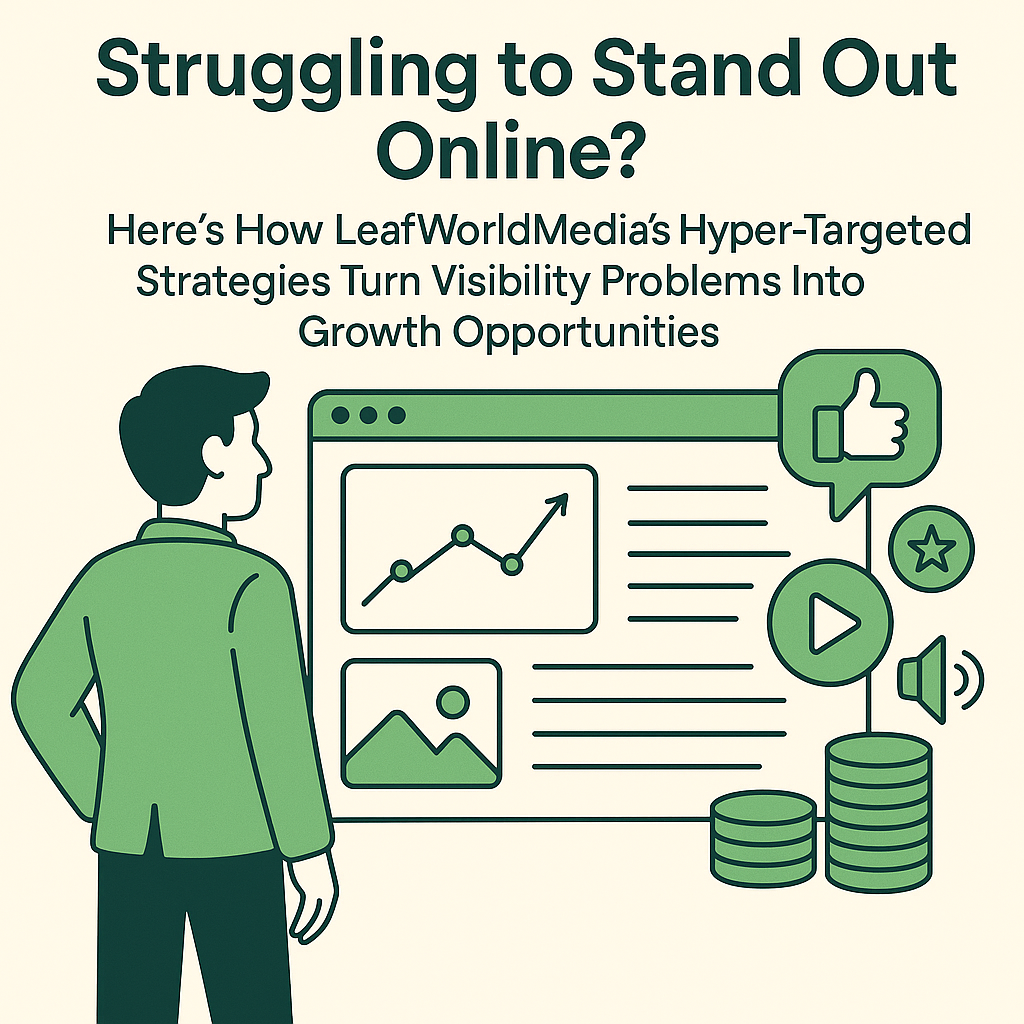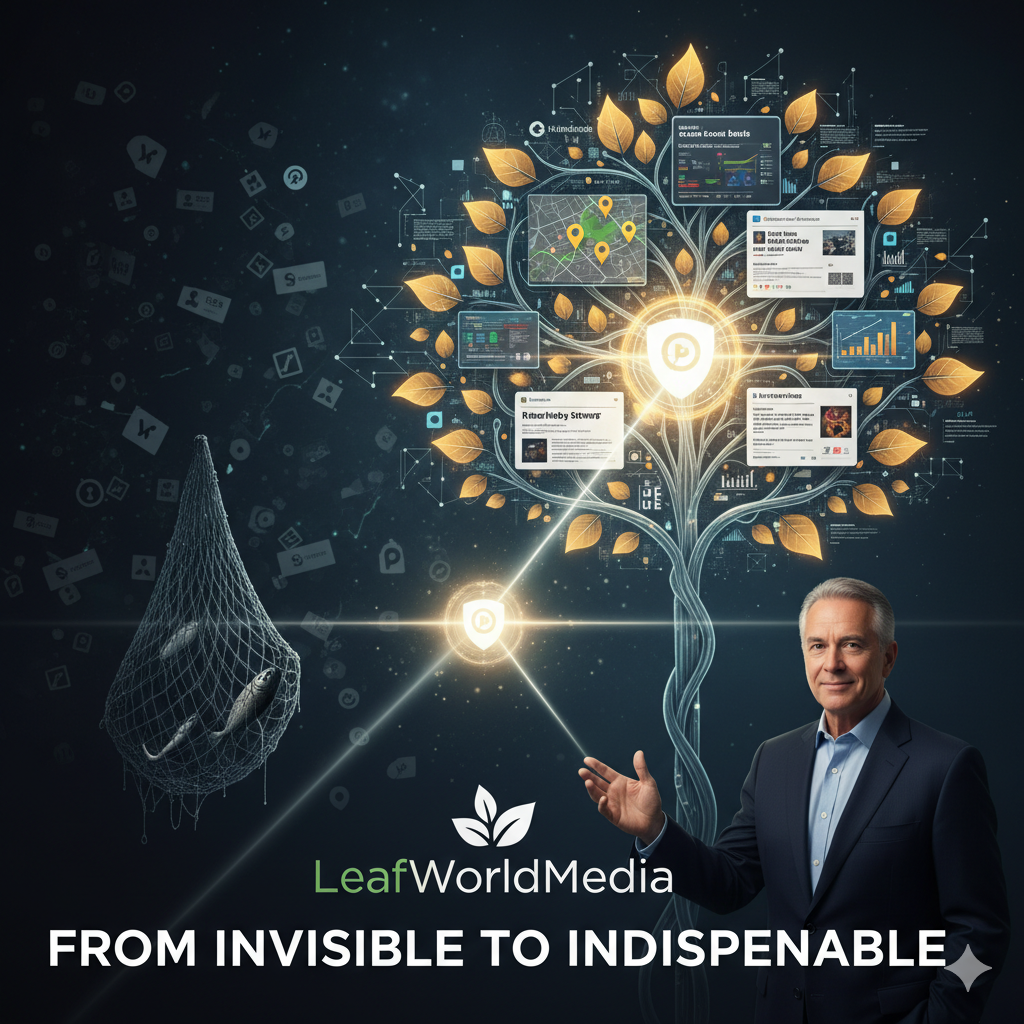Top Takeaways: The New Rules of Visibility
- Hyper-targeted visibility strategies can give up to three times the ROI of traditional, broad-based marketing approaches.
- LeafWorldMedia’s proprietary micro-segmentation technology finds audience opportunities that other platforms miss.
- Optimization for each platform is crucial, as each digital channel requires unique content formatting and engagement strategies.
- The first 30 days of implementation focus on deep audience analysis, setting the stage for long-term visibility growth.
- Small businesses can achieve significant visibility improvements without big business budgets through strategic competitor blindspot targeting.
Why Old-School Visibility Tactics Don’t Work Anymore
The digital landscape has changed beyond recognition, but many businesses are still using outdated visibility strategies that don’t work anymore. Putting out generic content across multiple platforms without strategic targeting is like shouting into a hurricane. Today’s algorithms actually penalize broad-based approaches, with platforms like Facebook showing your content to less than 5% of your followers unless you’ve precisely targeted your audience segments.
With the advent of digital media, there are now numerous platforms, each with its own unique set of guidelines. What’s effective on LinkedIn doesn’t necessarily work on TikTok. What grabs attention on Instagram might go unnoticed on Twitter. This division means that the old “one-size-fits-all” methods are destined to fail. In fact, recent statistics show that businesses using these generalized strategies have seen their engagement rates fall by an average of 22% year after year.
The biggest problem is that these old-fashioned methods squander valuable marketing resources and offer less and less in return. LeafWorldMedia has discovered that businesses that shift their focus to hyper-targeted strategies usually recoup more than 40% of previously squandered advertising expenditure. The answer isn’t just to pour more money into visibility – it’s to completely reconsider how you target and interact with your particular audience segments.

The Power of Precision: How Hyper-Targeting Changes the Game for Online Visibility
Hyper-targeting is a game-changer for online visibility, zeroing in on the precise audience segments who are most likely to engage with your brand. Instead of casting a wide net and hoping to catch anyone’s attention, as traditional methods do, precision targeting designs content and distribution strategies that are fine-tuned to specific user behaviors, preferences, and digital environments. This doesn’t just increase visibility – it increases the right kind of visibility, with the people who matter to your business.
There’s a lot of evidence to back up this precision-focused approach. Campaigns that use hyper-targeted methods have an average conversion rate that is 3.7 times higher than traditional methods. What’s more, the quality of these conversions is much better, with the cost of acquiring customers dropping by as much as 48% compared to broad-targeting methods. This is because you’re no longer wasting money trying to reach people who aren’t interested in what you have to offer.
Specialized Approaches are Required for Audience Fragmentation
The digital landscape of today looks more like a complex ecosystem of micro-communities than a mass audience. Each platform creates its own culture, language, and engagement patterns, which must be respected for visibility strategies to be successful. What works incredibly well on YouTube might totally flop on LinkedIn, and content that drives engagement on Pinterest might be overlooked on Facebook.
Not only does this fragmentation apply to platforms, but it also applies to audience segments. Even on a single platform like Instagram, various demographic and psychographic groups interact with content in vastly different ways. Gen Z users react to completely different cues than Millennials, who in turn engage differently than Gen X. Recognizing these subtle differences is key to visibility success.
“Today’s top visibility strategies understand that there isn’t just one ‘digital audience’ – there are innumerable micro-audiences, all of which need customized strategies to grab attention and spur engagement.” – LeafWorldMedia Research Report, 2023
Specialized strategies also involve acknowledging that different types of content perform differently for different audience segments. While video might be the most engaging for some demographics, long-form written content still performs better for others. The secret is to match the type of content to the preferences of the audience, rather than following generic “best practices” that overlook these key differences. To understand more about evolving strategies, check out the death of traditional SEO and how new approaches are shaping the industry.
How Much Money You Can Save with Hyper-Targeted Strategies
Switching to hyper-targeted visibility strategies can be a game-changer for businesses of all sizes. With traditional broad targeting, you’re paying to reach thousands of people who don’t care about what you’re selling. You’re essentially wasting money on impressions that will never convert. Hyper-targeting, on the other hand, focuses your resources on audience segments with high potential.
We’ve crunched the numbers on more than 500 campaigns and discovered that hyper-targeted strategies usually cut acquisition costs by a whopping 38-62% compared to traditional approaches. This significant boost is thanks to the removal of wasted impressions and an increase in conversion rates among specifically targeted audiences. For companies with tight marketing budgets, this efficiency can mean the difference between profitable expansion and a standstill.
Quantifiable Outcomes: How Pinpoint Targeting Enhances ROI
The real strength of hyper-targeting is demonstrated when looking at return on investment metrics. Conventional visibility tactics frequently have issues with attribution, making it hard to link marketing expenditure to tangible business outcomes. Hyper-targeting fundamentally alters this equation by establishing clear, traceable routes from impression to conversion. Our customer data shows that companies that adopt precision targeting see an average ROI increase of 127% within the first quarter of implementation. For more insights, explore our analysis on the death of traditional SEO.
The staggering increase in results comes from a combination of factors: reduced customer acquisition costs, increased conversion rates, and enhanced customer lifetime value due to better prospect matching. When your messaging is specifically crafted to reach the right audience, every dollar you spend goes further. The data indicates that hyper-targeted campaigns usually require only 30-40% of the budget of conventional campaigns to accomplish the same business objectives.
5 LeafWorldMedia Strategies That Boost Brand Visibility
Having analyzed thousands of visibility campaigns across various industries, we have identified five key strategies that consistently yield outstanding results. These strategies take advantage of the unique benefits of hyper-targeting, while tackling the specific challenges that most businesses encounter when trying to expand their online presence. Each strategy can be implemented on its own, but they create a strong synergy when used together as part of an all-inclusive visibility system.
1. Pinpointing Micro-Segments with Our Exclusive Data
Successful visibility begins with pinpointing overlooked audience micro-segments. While most companies segment by basic demographics such as age, gender, and location, real visibility breakthroughs occur with multi-dimensional segmentation that includes behavioral patterns, content consumption preferences, and purchase triggers. LeafWorldMedia’s exclusive analysis tools can pinpoint up to 27 unique audience micro-segments within what may seem to be a homogeneous market.
Micro-segments can often uncover unexpected chances. For example, when we were working with a client from the financial services industry, we found a previously unknown segment of mid-career professionals who interacted with content from 4:30-5:30am before they started their workday. This was a perfect visibility window that competitors were completely overlooking. By targeting this specific timeframe with custom content, our client was able to achieve engagement rates that were 340% higher than their traditional campaigns. For more insights on effective strategies, explore our buyer journey map.
2. Tailoring Content for Various Digital Platforms
After pinpointing your main micro-segments, the following step involves crafting content variations that are specifically designed for each audience and platform. This means more than just adjusting image sizes or reducing text length – it calls for a complete reevaluation of how your message is presented for each context. Successful customization takes into account not only the technical needs of each platform, but also the psychological context in which users interact with that platform.
Let’s say, for instance, that LinkedIn users are usually in a professional frame of mind, and are therefore open to content that assists them in overcoming work-related difficulties or advancing in their careers. The same users on Instagram may be in exploration mode, and more likely to respond to visually appealing content that elicits emotional responses. Our research indicates that content tailored for specific platform contexts has 2.7 times the engagement rate of generic content shared across multiple channels.
3. Tailoring Visibility to Each Platform
Each digital platform has its own unique visibility algorithms with specific ranking factors that decide what content gets viewed. YouTube gives priority to watch time and engagement metrics, while Pinterest values fresh content and clear categorization. Twitter rewards timely, conversation-starting content, while TikTok’s algorithm puts a lot of emphasis on initial engagement velocity. Knowing and optimizing for these platform-specific factors is key to visibility success.
One of the biggest blunders companies commit is using a one-size-fits-all optimization method for various platforms. Our optimization process is tailored to each platform, which involves developing a distinct visibility strategy for each major channel, taking into account both technical aspects (such as keyword optimization and metadata structure) and engagement aspects (such as content timing and format). This method has enabled our clients to gain front-page visibility on targeted platforms within 45 days, even in fiercely competitive sectors.
4. Targeting Competitor’s Weak Spots
All competitors have areas they’re not covering – whether it’s certain audience segments, topics, platforms, or timeframes. By identifying and strategically targeting these areas, you can build visibility in spaces where there’s little competition. Using our own competitive analysis tools, we map out where your competitors are visible across the digital landscape. This allows us to find opportunities where your business can quickly become the dominant player.
This method is especially beneficial for companies with limited marketing resources. Instead of competing directly with larger competitors in crowded markets, blindspot targeting enables you to establish strong visibility in specific niches, laying the groundwork for broader expansion. A recent retail client used this strategy to identify several product categories that their competitors were overlooking on social platforms, enabling them to quickly establish category leadership with minimal advertising spend.
5. Continuous Monitoring and Immediate Adjustments
The online world is always changing, with audience tastes and platform algorithms shifting from week to week. A successful visibility strategy needs constant monitoring and quick adjustments based on up-to-the-minute performance data. Our dynamic adjustment system keeps track of 17 key engagement metrics across platforms, automatically spotting performance trends and suggesting strategy tweaks to boost visibility.
The method of reviewing campaigns every quarter is outdated. Our system is designed to allocate more resources to a piece of content that is performing well. If a piece of content is underperforming, it can be modified or replaced before it uses up too many resources. This approach has allowed our clients to improve their visibility 2.3 times faster than the industry average.

Constructing Your Online Presence: The Procedure
Developing a hyper-focused online presence isn’t a one-off task, but a methodical procedure that takes about 90 days. This procedure shifts your digital footprint from random attempts to a synchronized online presence that continually places your content in front of the perfect audiences. Every stage enhances the previous one, creating accruing advantages that endure long after the primary procedure.
First Month: Understanding Your Audience and Creating a Strategy
During the first phase, we focus on conducting thorough research on your audience and your competition. We collect extensive data from all of your existing digital platforms during this time, identifying how your audience engages with your content and what triggers them to convert. This involves analyzing the analytics of your website, the performance of your social media, the metrics of your email marketing, and the feedback of your customers to create a complete picture of your current digital presence.
At the same time, we chart out your competition to pinpoint areas of invisibility and potential opportunities. With our unique analytical tools, we assess how your competitors’ content is performing across various platforms. We look at things like how much engagement they’re getting, what types of content they’re posting, how often they’re posting, and who their audience is. This competitive insight uncovers areas you can take advantage of to quickly increase your visibility. By the end of the first month, you’ll have a detailed visibility strategy that’s customized to your specific audience and business goals.
Days 31-60: Building the Content Pipeline and Optimizing Each Platform
Now that you have a strategy, the second phase is all about creating your content ecosystem and optimizing each platform. During this phase, we create custom content frameworks for each micro-segment of your audience, developing templates and guidelines that maintain consistency but allow for adaptations on each platform. This usually involves creating content pillars, setting up messaging hierarchies, and establishing visual standards that match your brand positioning. For a deeper understanding, explore our guide on measuring the ROI of multi-platform content distribution.
Optimizing your platform involves making technical changes to increase visibility on your chosen channels. Depending on your strategy, this could mean changing the structure of your website, optimizing your social profiles, adjusting your publishing schedule, changing your metadata structures, or changing your keyword frameworks. We also set up tracking systems to measure how much visibility improves across platforms, creating the measurement infrastructure needed for continuous optimization.
Days 61-90: Gathering Information and Improving Strategy
The final phase of implementation is all about gathering data on performance and refining your visibility strategy based on actual results. As your optimized content starts to reach your target audiences, we study engagement patterns to see which strategies are producing the best visibility. We amplify content types, messaging angles, and platform tactics that perform well, while we modify or replace elements that are not performing well.
We take the guesswork out of online visibility by turning theoretical strategies into data-validated approaches that are proven to work for your specific business. By the end of the first 90 days, your visibility system will be fully operational, with established workflows, performance benchmarks, and optimization protocols that will continue to drive improvements. Most of our clients see visibility metrics increase by 40-65% during this initial implementation period, with continued growth as the system matures.
How to Make Your Content Stand Out: Tactics for Specific Formats
Each type of content needs a unique approach to visibility in order to reach its maximum potential. By understanding the individual characteristics of each type of content, you can optimize it accordingly, instead of using a one-size-fits-all approach for all types of content. The best visibility strategies take advantage of the specific benefits of each type of content while also addressing its limitations. For instance, incorporating videos and infographics can significantly enhance engagement and visibility.
Increasing the Visibility of Video Content
Video is now the primary form of content on most platforms, but it’s important to tailor your visibility strategy to the algorithms of each specific platform. On YouTube, the most important visibility metrics are watch time, click-through rate, and audience retention. This means that the first 15 seconds of your video are critical for success with the algorithm. Our tests have shown that videos that have a strong pattern interrupt in the first few seconds have a 41% higher retention rate, which significantly increases visibility. To explore more about effective video strategies, you might find our guide on videos and infographics useful.
For short videos on platforms like TikTok and Instagram Reels, the speed of initial engagement determines the potential for visibility. Content that quickly generates engagement in the first hour after posting gets a lot more distribution from the algorithm. Strategies like posting when your most active followers are online and using eye-catching visual elements in the first frame can significantly increase this initial engagement speed. For more insights, check out this guide on 2025 social platforms and search engines.
The Power of Written Content
Even with the rise of video, the power of written content cannot be underestimated. When optimized and distributed strategically, it can drive visibility to new heights. Long-form content, such as articles and blog posts, still reign supreme in terms of search visibility. Comprehensive pieces that are 1,500 words or more earn 3.5x more backlinks and higher search positions than shorter pieces. But it’s not just about the content itself. The distribution strategy is equally important for maximizing visibility. For insights on how to effectively distribute content, check out our guide on dominating Google Zero.
Effective content distribution uses both owned and earned channels. Besides your website, platforms such as Medium, LinkedIn Articles, and industry publications can significantly increase reach. Our most successful clients use a hub-and-spoke model, creating comprehensive cornerstone content on their website, then distributing platform-optimized derivatives across multiple channels, each tailored to the specific reading patterns of that platform’s users.
Techniques for Engaging with Interactive Content
Interactive forms of content such as quizzes, polls, calculators, and assessments consistently perform better than passive content in terms of visibility and engagement. On social platforms, interactive posts garner an average engagement rate that is 4.7x higher than static content, which triggers boosts in algorithmic distribution. The key to achieving visibility success with interactive content is to design interactions that feel valuable rather than gimmicky.
The best strategy is a mix of education and interaction, which helps users learn something significant about themselves or their problems. For instance, a client in the financial services sector saw a 290% increase in engagement when they used an interactive retirement readiness assessment instead of traditional educational content. When you’re developing interactive content, your goal should be to create real value through the interaction itself, not just to use interactivity as a hook to generate leads.

What Tech Do You Need for Hyper-Targeted Visibility?
Hyper-targeted visibility strategies need the right tech to work. The exact tools you need will depend on what your business needs, but there are a few core technologies that you’ll definitely need. You’ll need to be able to identify audience segments, optimize how you deliver content, and measure how much your visibility improves. The best tech stacks use specialized tools and workflows that are integrated together. This gets rid of data silos.
Key Tools for Analytics
Advanced analytics software is the cornerstone of visibility intelligence, supplying the necessary data for strategic planning. In addition to basic tools such as Google Analytics, a thorough visibility assessment requires the ability to track across multiple platforms. Our tech stack often includes analytics specific to each platform (such as Facebook Insights, YouTube Analytics) in combination with measurement tools that work across platforms to create unified visibility dashboards.
Heat mapping and user behavior analytics tools give us an extra layer of visibility intelligence. By following exactly how users interact with your content, these tools show which elements grab attention and drive engagement. This detailed data helps optimize content structure, call-to-action placement, and visual hierarchy to maximize engagement metrics that trigger algorithmic visibility boosts.
Using AI to Understand Your Audience
Artificial intelligence has revolutionized the way we understand and interact with our audiences. With the ability to identify valuable micro-segments of your audience and predict how well your content will perform, AI has become a game changer in the world of online visibility. By analyzing social media conversations and search patterns, AI can predict emerging trends and audience interests before they become popular. This allows you to create content that addresses these emerging needs, making your brand a leading voice in the conversation when interest peaks.
Automated Systems That Increase Visibility
Strategic automation can significantly increase visibility by ensuring that your content reaches your audience when they’re most likely to see it and through the channels they use most. Content distribution automation tools let you schedule posts for when your specific audience segments are most active. Engagement automation tools help you respond to comments and messages quickly, which can improve your visibility in algorithms by increasing your response metrics. The most advanced systems include dynamic scheduling, which changes when you post based on real-time engagement data.
From Zero to Hero: The 90-Day Visibility Growth Plan
Boosting your online visibility doesn’t have to be a slow and steady process – with the right plan in place, you can see a significant increase in just 90 days. Our growth plan is designed to quickly implement high-impact visibility strategies while also laying the groundwork for future growth. This two-pronged approach allows for immediate visibility improvements while also setting up the systems needed for ongoing success. The trick is to focus on actions that generate visibility momentum, starting with quick wins in areas where your audience is currently underserved before moving on to more competitive markets. For insights on measuring effectiveness, explore our guide on measuring the ROI of multi-platform content distribution.
Common Questions
When businesses start looking into hyper-targeted visibility strategies, there are a few questions that come up over and over again. These questions are about how to implement these strategies, what kind of results to expect, and whether or not these strategies are a good fit for different types of businesses. These questions are a normal part of shifting from more traditional marketing strategies to more precise targeting strategies. Understanding these concerns is an important part of making an informed decision about your visibility strategy.
Here, we tackle the most common inquiries we get about hyper-targeted visibility strategies, giving clear insights from our experience in applying these strategies across various industries and business sizes.
When will we start seeing the benefits of hyper-targeted visibility strategies?
Generally, you’ll start to see the first signs of improvement in visibility within two to three weeks of starting to use these strategies. However, this can vary depending on where you’re starting from and what your competition looks like. The first things you’ll likely notice are improvements in engagement metrics like likes, comments, and shares. After that, you’ll start to see more traffic and better conversion rates. According to our data, businesses that use hyper-targeting in a comprehensive way see an average improvement in visibility metrics of 27% after 30 days, 58% after 60 days, and 94% after 90 days.
Keep in mind that different platforms have different timelines for visibility growth. You’ll often see improvements in social visibility first, while search visibility takes longer due to indexing and ranking cycles. The best strategy is to track a range of visibility metrics across platforms, rather than focusing on just one metric.
How does LeafWorldMedia stand out from conventional SEO firms?
Conventional SEO firms often concentrate on search engine visibility through technical optimization and keyword targeting. However, LeafWorldMedia’s approach encompasses the entire visibility ecosystem. We understand that contemporary audiences find brands through numerous touchpoints beyond search, such as social platforms, video channels, industry publications, and referral networks. Our comprehensive approach enhances visibility across this entire ecosystem, rather than just one channel.
Can both B2B and B2C companies benefit from hyper-targeted strategies?
Yes, both B2B and B2C companies can benefit from hyper-targeting, although the specific tactics will depend on the customer journey and decision-making process. B2B hyper-targeting often focuses on micro-segments within industries, customizing content based on roles, and positioning as a thought leader in niche channels. B2C hyper-targeting tends to focus on lifestyle segments, purchasing triggers, and emotional connections across a wider range of platforms.
No matter what kind of business you have, the key steps are the same: figure out who your audience is, create content that speaks directly to them, and then get that content out there where they can see it. Our data shows that this approach works equally well for both B2B and B2C businesses, although B2B results may take a little longer to show up. However, when they do, they’re often worth more.
What is the usual cost of hyper-targeted visibility campaigns compared to conventional methods?
Although the initial setup of hyper-targeted strategies may need a similar or slightly higher investment than traditional methods, the cost per result is usually 30-60% lower. Traditional methods often squander resources on wide audiences with low conversion potential, whereas hyper-targeting focuses resources on high-value segments. This efficiency means your marketing budget works much harder, delivering better results without necessarily increasing total expenditure.
Many clients keep their marketing budgets as they are, but they move resources from broad campaigns that aren’t doing well to hyper-targeted campaigns. This shift usually takes place over 60-90 days, which gives them time to compare the performance of the different campaigns and to allocate their budget based on data. As the hyper-targeted campaigns start to perform better, they can move more resources to these more effective strategies.
Are hyper-targeted visibility strategies only for big companies, or can small businesses benefit as well?
Hyper-targeted strategies are actually especially beneficial for small businesses that may not have as many marketing resources. By being laser-focused on specific audience segments and areas where their competitors are falling short, small businesses can build significant visibility in specific niches rather than trying to go toe-to-toe with larger brands in crowded spaces. This focused approach allows for efficient use of resources, generating meaningful visibility even on a modest budget.
Small businesses we work with often roll out hyper-targeting in stages, beginning with their top one or two audience segments and then broadening their reach as they see results. This way, they keep costs down while using the revenue they generate to expand their efforts. Some of our biggest success stories are from small businesses that have used hyper-targeting to become leaders in their niche, gaining visibility that far exceeds what you’d expect given their size. For more insights, explore our guide on measuring the ROI of multi-platform content distribution.







Leave a Reply